|
|
The 1960 ‘Anpo’ Struggle inThe People’s Daily/人民日報: Shaping Popular Chinese Perceptions of Japan during the Cold War
Introduction
Rising China-Japan friction in 2012 has centered on territorial claims over the Diaoyu/Senkaku islands and, like many such clashes since the early 1990s, it is bound up with unresolved legacies of the Asia-Pacific War. Indeed, as much valuable research on the politics of memory in contemporary East Asia has demonstrated, the politicized anger and bitterness that characterize the China-Japan relationship today have a complex archeology.[sup]2[/sup]For example, during the 1950s and 1960s the United States, not Japan, was by far the primary geopolitical and ideological enemy of the PRC. In that context, the CCP sought to lure Japan from its American geopolitical embrace, persuade the Chinese people to “forgive and forget” matters of the Japanese invasion, and ultimately recast the popular Chinese perception of Japanese society from that of wartime enemy to regional geopolitical ally.[sup]3[/sup]
This essay takes as its subject one example of this re-conceptualization of Japanese society in Chinese political ideology – editorial cartoon representations of the 1960 protests against the renewal of the U.S.-Japan Security Agreement (“anpo jōyaku” 安保条約).[sup]4[/sup]Widely recognized as the largest popular anti-government demonstrations in postwar Japanese history, the Anpo protests are most often analyzed strictly within the context of U.S.-Japan relations.[sup]5[/sup]Looking at these events from a Chinese perspective opens up a number of useful interpretive vantage points. While the core editorial attack launched in these cartoons is aimed squarely and primarily at the United States, particularly striking is the manner in which the CCP employed these images to transform popular Chinese perceptions of Japan in ways that reflect the altered geopolitical environment of the early postwar era in East Asia.[sup]6[/sup]This series of editorial cartoon examples from the summer of 1960 illustrates three main themes, all of which are inherent in Chinese political and social rhetoric of the era: the inevitable failure of American geopolitical strategy, the advance of a revolutionary future that will tear down the feudal past, and the irrepressible power of mass movements. The CCP employed these thematic visual representations of anti-U.S. and anti-government protests in Japan for two primary reasons: 1) to legitimatize its leadership in both domestic and international spheres in the eyes of Chinese society; and 2) to cultivate of a perception of postwar Japanese society among the Chinese public that differentiated conservative, U.S.-backed political elites from the Japanese masses, whose interests were ideologically similar, if not identical, to those of the Chinese people.[sup]7[/sup]
The CCP’s emphasis on a positive relationship with popular Japanese society in this manner during the early 1960s is strikingly different from what one finds in China since the early 1990s. More precisely, whereas the party relies upon the power of popular memories of victimization during the war against Japan to bolster nationalism in the contemporary PRC, during the early 1960s memories of the Japanese invasion did not need to serve the same political purpose.[sup]8[/sup]That is not to say, of course, that the war against Japan was entirely ignored before the 1990s. Historical representations of the war in which the CCP played a more significant role than the Guomindang in defeating Japan, for example, were routinely employed by the party to discredit the Nationalist regime on Taiwan throughout the Cold War era. The position of the United States as China’s main ideological opponent during the summer of 1960, however, made it possible for the CCP to depict Japanese society in a more complex and multi-dimensional light than is the case today. As one recent study suggests, “a willingness to downplay contentious memories of the wartime past in order to maximize the economic and strategic benefits of closer relations” is a recurring pattern of behavior in China’s postwar foreign policy concerning Japan.[sup]9[/sup]This essay is one exploration of that pattern.
The Inevitable Fall of American Puppet Regimes
One of the most common themes at work in these images is that of Japanese Prime Minister Kishi Nobusuke ( 岸 信介) facing the identical fate of South Korean President Syngman Rhee (李承晩). Rhee had ruled South Korea with an iron (and fiercely anti-Communist) fist after being installed as President by the United States in 1948. After widespread popular protests against the elections that had reaffirmed his position in the spring of 1960, Rhee fled into Hawaiian exile in late April. Chinese cartoonists made quick use of this episode in characterizing events that began to unfold in Japan in May.
[table=300px][tr][td]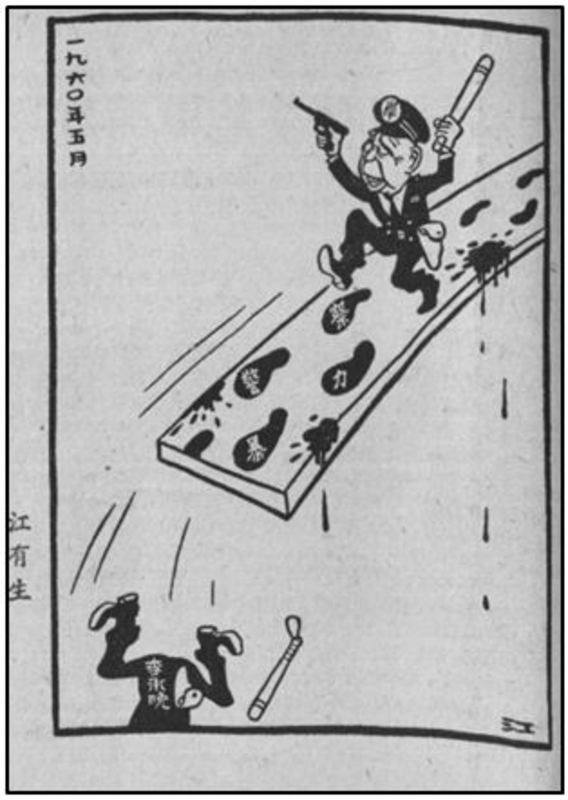
Figure 2.[sup]10[/sup][/td][td]
Figure 3.[sup]11[/sup]
[/td][/tr][/table]Figure 2 shows Prime Minister Kishi walking the plank, so to speak, of police brutality (警察暴力), pistol in one hand, club in the other. Kishi steps in line with the bloody footprints of one who has already walked this path, Syngman Rhee, who is shown falling headfirst into the abyss. Kishi blindly follows, seemingly oblivious to the dangerous fate that awaits him. In a more gruesome depiction of the same notion, Figure 3 shows the interior of a burial tomb where Rhee has already been laid to rest (the captions reads – ‘to be buried with those who came before’ 陪葬的先来). Kishi is being brought inside by a masked mortician to take his place next to the largest sarcophagus in the center of the tomb – the one waiting empty for the leader of the American empire ( 美帝国主文). The figure to the left is Prime Minister Adnan Menderes
(曼德列斯)of Turkey, an association to be explained momentarily.
[table=350px][tr][td]
Figure 4.[sup]12[/sup][/td][td]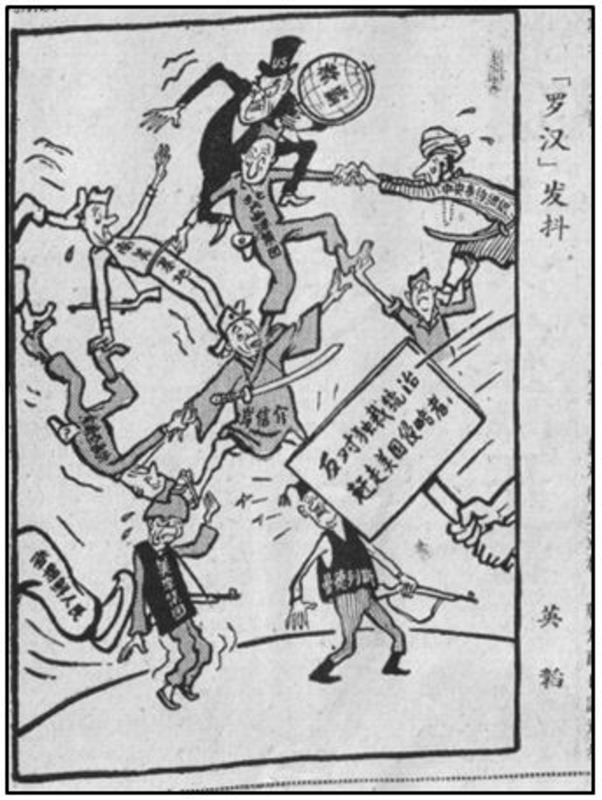
Figure 5.[sup]13[/sup][/td][/tr][/table]
Other examples build on the comparisons to Syngman Rhee and link events in Japan to revolutionary actions in numerous parts of the world. Figure 4 depicts a row of pillars, with American capitalists hiding behind them, being knocked down by the battering rams of popular action. The faces visible on the pillars are those of Syngman Rhee and Kishi Nobusuke, and corresponding teams of anti-Rhee South Korean(南朝鮮人民反対美李集团的斗争)and anti-Kishi Japanese (日本人民反対岸信介政府的斗争) protesters can be found below along with the caption that reads - “an unstoppable force” (势不可当). The image also includes sombrero-wearing revolutionaries from South America (南美人民反独裁政府的斗争), a team of dark-toned Africans in the distance, and anti-Menderes Turks (土耳其人民反対曼德列斯政府) in the center. Similarly, Figure 5 depicts a collapsing human pyramid of puppet regimes supporting the U.S. capitalist at its apex. Kishi is positioned at the center with “South American bases 南美基地” on his shoulders and South Korea (the U.S.-Rhee bloc美李集团) and Turkey (again labeled specifically as Menderes 曼德列斯) under his feet. A kick from the South Korean people sets the tower shaking.
While the South Korean connection has been explained, the link with Turkey is less obvious. The Turkish Prime Minister, Adnan Menderes, had come under fierce pressure from the country’s military establishment in early May 1960 in the form of demands for political reforms and an end to corruption. While the coup d’état that later drove Menderes from power was hardly a popular revolution, Menderes was considered to be pro-American by his political opponents in Turkey, thus resistance to his administration could be employed in China as an example of widespread dissatisfaction around the world with US-backed governments. It is not unreasonable to assume that memories of Turkey’s involvement in the Korean War a decade earlier might also have given the Chinese reason to celebrate any opposition to the government of President Celal Bayar and his Prime Minister, Menderes.[sup]14[/sup]Figure 6 reflects this by suggesting the volcano of popular energy then erupting in Japan was one part of a worldwide seismic event that included eruptions in South Korea and Turkey (the caption reads - “in the days when the world is turned upside down 在天翻地夏复的日子里”). The cartoon also references the recently publicized U-2 incident, in which a secret American reconnaissance plane had been shot down over the Soviet Union on May 1, 1960. That pilot Francis G. Powers’ aircraft was permanently based in Turkey perhaps adds to the logic of including Turkey within this group of U.S. satrap regimes around the world. The United States, represented by a hapless Eisenhower, is being blown sky high by these volcanic explosions of popular resistance to American-backed puppet regimes.[sup]15[/sup]
After a military coup drove Menderes from power in late May, it seemed that prognostications of anti-American movements around the world were proving true. Figure 7, published after the coup in Turkey, reflects this by showing a cowering Eisenhower, labeled again as the ‘leader of the American empire’ ( 美帝国主文), having the teeth of his puppets Rhee in Korea and Menderes in Turkey pulled out by the calipers of the people in both nations, with Japan in the center to follow. In fact, the comic in Figure 3 (published before the coup), which depicts Menderes lying dead in a tomb, proved eerily prescient – Menderes was later executed in September 1961 after a trial by the military junta that unseated him.
[table=300px][tr][td]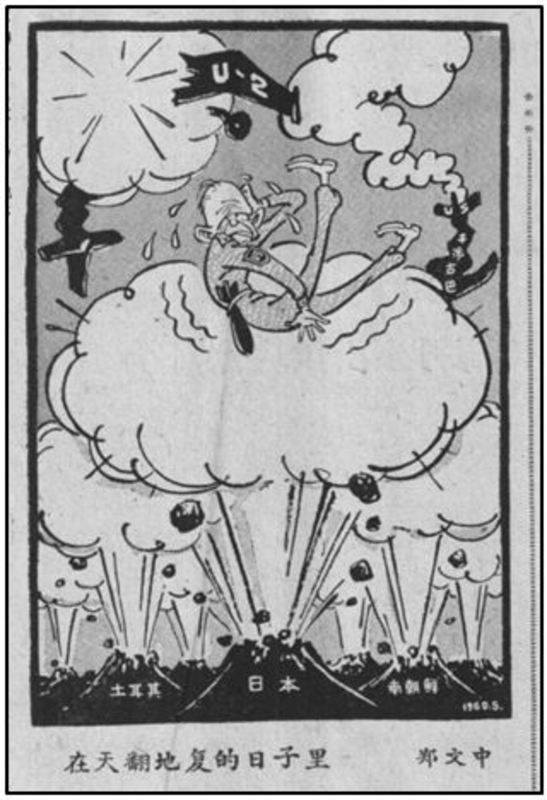
Figure 6.[sup]16[/sup][/td][td]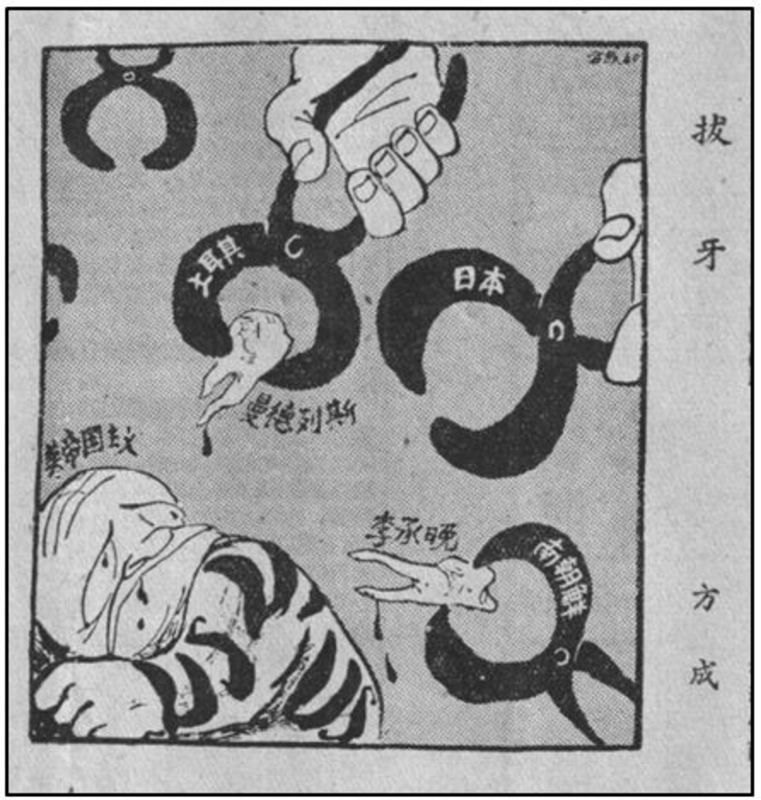
Figure 7.[sup]17[/sup][/td][/tr][/table]
What all these examples share is an emphasis on the notion that U.S.-backed regimes around the world will not – indeed, cannot – survive, because they stand in opposition to popular will. Linking events in South Korea, Turkey and Japan to this general principle of Maoist revolutionary thinking was a useful tool for illustrating the universality of the CCP’s strategic vision. Moreover, it encouraged the viewer to see the fate of popular resistance to U.S. aggression in Japan as linked to that of China’s own popular struggle against foreign imperialism.
[table=300px][tr][td]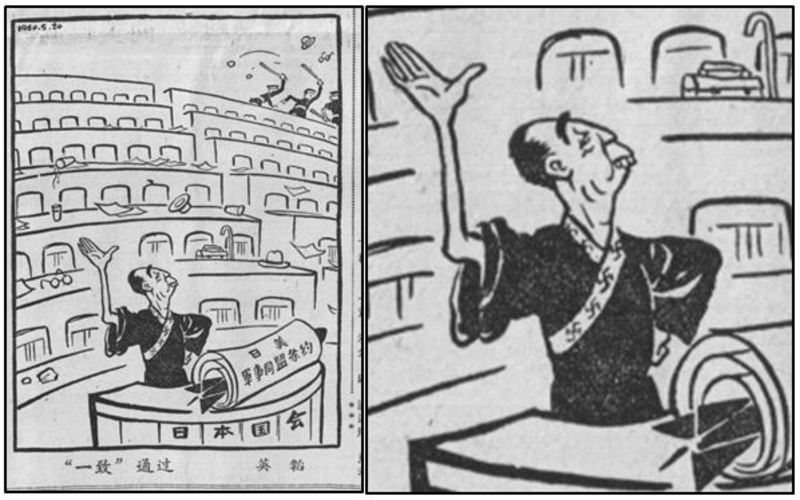
Figure 8.[sup]19[/sup][/td][/tr][/table]Kishi as Fascist Thug and Feudal Clown
Prime Minister Kishi Nobusuke provided the emblematic comic depiction of Japan during the summer of 1960. Not only was Kishi Japan’s top leader, but he had been jailed as a war criminal during the U.S. occupation period because of his influential position within Japan’s imperial administrative machinery of control in Manchuria. Having being released in 1948, however, Kishi was politically rehabilitated, like many other previously jailed war criminals, with the end of the US occupation in 1952.[sup]18[/sup]Kishi was known in China for having played a key role in Japan’s brutal occupation of China’s northeast, making him a particularly inviting target for ridicule. Moreover, Kishi had personally spearheaded the effort to renew the US-Japan Security Treaty in 1960, making him the primary domestic target of most Anpo-related protests in Japan. By focusing on Kishi, the CCP could thus draw a clear distinction between Japan’s conservative political elites and the Japanese people as a whole. Doing so made it possible to condemn the Japanese government and its American backers while simultaneously expressing sympathetic support for the Japanese people.
There are two common themes in these depictions of Prime Minister Kishi – fascist thug and feudal clown. Returning to the image in Figure 2, Kishi is donning garb that looks remarkably similar to that of a Nazi SS officer (complete with a German luger-style pistol), with his high-stepping march in black boots perhaps reinforcing the same impression. More explicitly, in Figure 8 Kishi presides grandly over the Diet session in which the U.S.-Japan Security Agreement has been successfully ratified, but the hall is emptied by Kishi’s club-wielding police goons driving the last remnants of opposition out of the room. The caption reads sarcastically, “‘unanimously’ passed” (‘一致’通过 ). Moreover, Kishi’s kimono is lined with swastika trim, making the Nazi reference less than subtle. In short, the message is that Kishi has employed fascist violence to crush popular will and ram through his pro-U.S. agenda, depicted here as the Anpo treaty wrapped around a missile.
With equal consistency, however, Kishi is also depicted as a kimono-clad,geta-wearing relic of Japan’s feudal past, as seen in the images below. In part, of course, this is meant to make Kishi look foolish, weak and incompetent. The consistency with which Kishi is shown in ‘traditional’ Japanese garments and footwear, however, also suggests that he represents a feudal past that will soon be overcome by a revolutionary future. Such a feeling is reflected well in Figure 13, which juxtaposes a kimono-clad Kishi against the more ‘modern’ looking six hundred million Chinese workers whose advance compels him to scamper away in his wooden sandals alongside Eisenhower in his suit and tie. In Figure 14, while Kishi appears in a Western suit, the seal with which he is trying to ratify the security agreement is topped with a sword-wielding Japanese militarist of the 1940s, again implying that Kishi represents the continuation of prewar militarism in postwar Japanese society, as the caption reads – “catch the hand of evil 抓住罪悪的手.”
[table=300px][tr][td]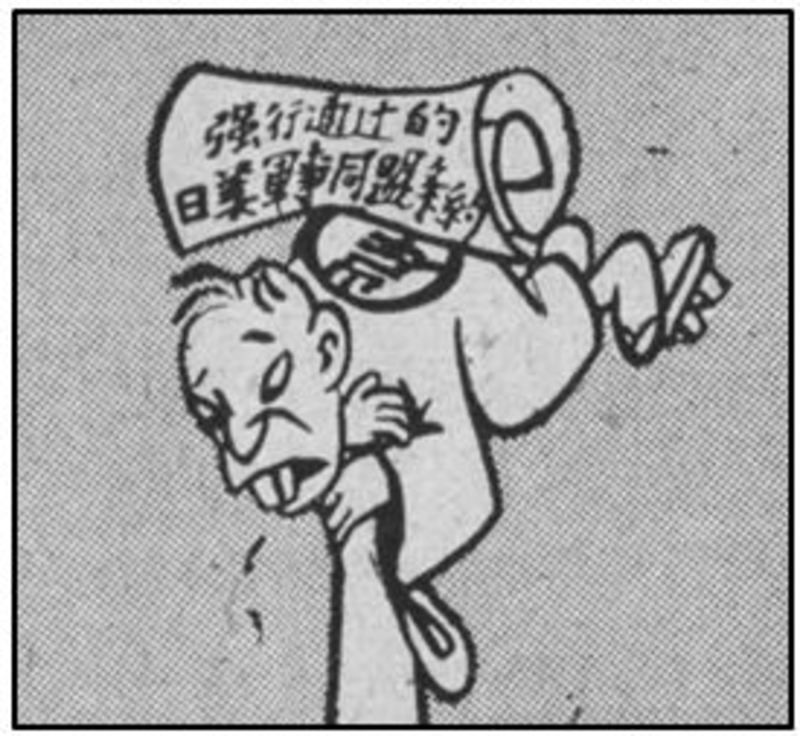
Figure 9.[sup]20[/sup][/td][td]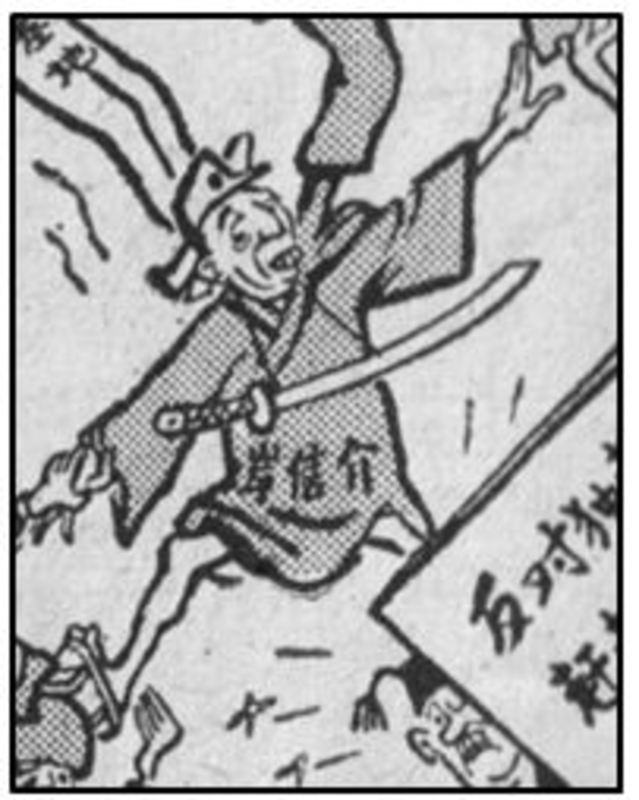
Figure 10.[sup]21[/sup][/td][td]
Figure 11.[sup]22[/sup][/td][td]  Figure 12.[sup]23[/sup][/td][/tr][/table][table=400px][tr][td] Figure 12.[sup]23[/sup][/td][/tr][/table][table=400px][tr][td]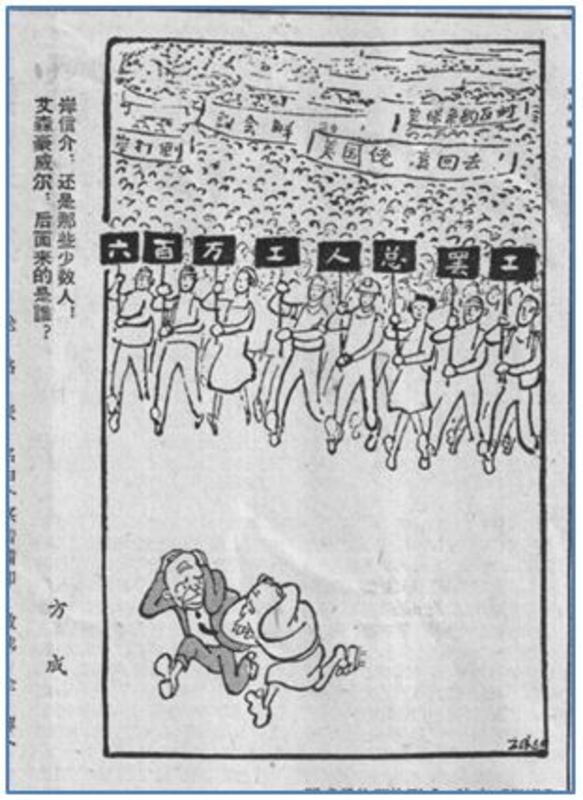
Figure 13.[sup]24[/sup][/td][td]
Figure 14.[sup]25[/sup][/td][/tr][/table]In each of these examples, there is a unifying concept. The popular Japanese struggle against renewal of the security treaty is more than just a contemporary political confrontation; it is also a battle between the progressive revolutionary vanguard that will determine Japan’s future and the reactionary elements of Japan’s feudal tradition that desperately cling to power in opposition to it.
Popular Protest as a Force of Nature
In many of these cartoons Japan’s physical geography is appropriated to depict popular anger toward the Kishi cabinet in dramatic and recognizable ways, such as in these uses of Mt. Fuji imagery.[sup]26[/sup]The scene featured previously in Figure 6, for example, shows President Eisenhower being blasted skyward by an eruption of Fuji, with volcanic explosions in South Korea, Turkey and several other unidentified locales in the distance. Figure 16 takes a different approach, focusing on Kishi instead of the U.S. President, but the underlying message is identical. Kishi is perched atop a Japan (represented figuratively by Mt. Fuji) that is simmering with popular anti-American struggle ( 日本人民反美斗争) sure to explode at any moment, burying Kishi and the Anpo treaty with it. Similarly, in Figure 17 Kishi vainly attempts to cap the explosive power of the Japanese people (again represented by Mt. Fuji) with his club of ‘police brutality’ ( 警察暴力 ) in the service of the Anpo treaty carried upon his back. The caption reads: “What a pathetic pillar of support” (可怜的支柱 ). In all three examples, the volcano embodies popular revolutionary energy that cannot be suppressed.
[table=300px][tr][td]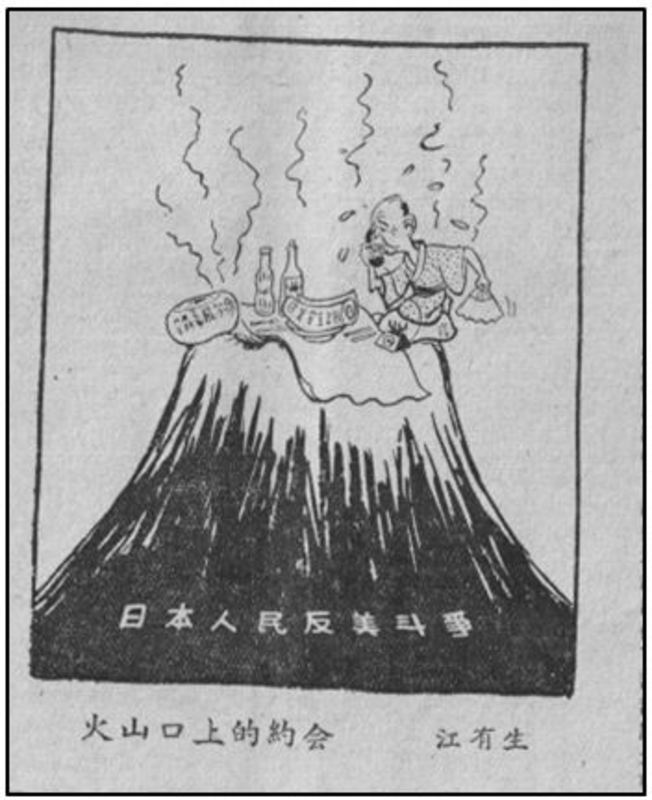
Figure 16.[sup]27[/sup][/td][td]
Figure 17.[sup]28[/sup][/td][/tr][/table]
A different use of Mt. Fuji is employed in Figure 18. Here the mountain is shown in the distance behind the peace memorial statue in Nagasaki commemorating those who perished there in the atomic attack of August 9, 1945. The mountain serves as a metonymic symbol of Japan (as Mt. Fuji is, in fact, not visible from Nagasaki), complete with cherry blossoms, while the ominous American bomber flying overhead carries a massive bomb labeled ‘U.S.-Japan military alliance’ ( 日美軍事同盟 ). The caption at the right can be read as ’Here we go again’ (又来了), an unambiguous suggestion that the U.S.-Japan alliance will likely bring nuclear disaster to Japan a third time.
[table=200px][tr][td]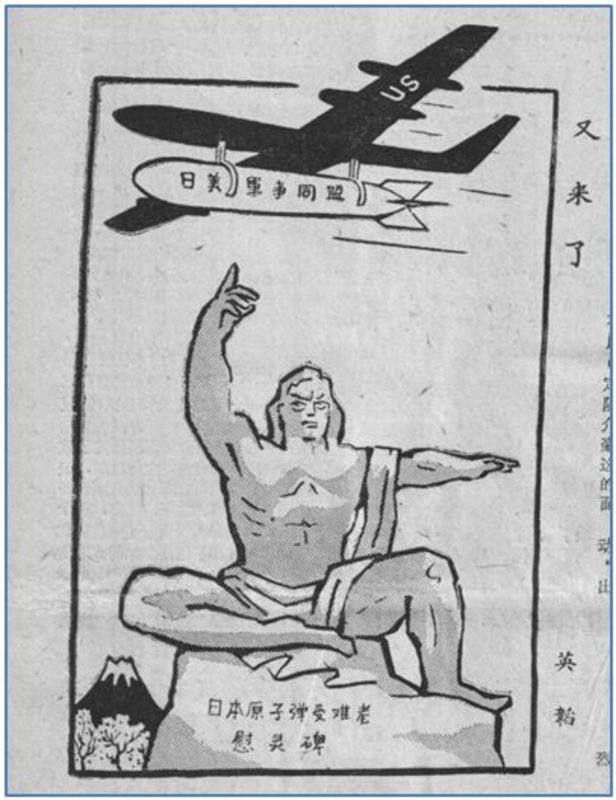
Figure 18.[sup]29[/sup]
[/td][/tr][/table]Even more striking is the use of tsunami imagery to represent the unstoppable energy of popular action against the Kishi regime and its American backers. More than just a general sense of the power unleashed by tidal waves, the images referenced a specific event. In early May 1960, a massive surge triggered by a high magnitude earthquake in Chile slammed upon Japan’s northeastern coast, the same region devastated by the March 11, 2011 tsunami, leaving dozens dead and thousands more homeless. Soon thereafter, cartoonists inThe People’s Dailyappropriated imagery of the disaster to dramatize the political and social disturbances then taking place in Japan. Figure 19, for example, shows crowds of Japanese protesters standing on the coast, fists raised high and banners flying, as giant waves sweep the United States (and its weapons) from the islands, and a massive hand plucks Kishi (in kimono and wooden clogs) from the swirling foam below. The caption reads: ‘The Security Treaty’ provides no security ( ‘ 安全条約 ’ 不安全). In Figure 20, enormous fist-shaped swells emblazoned with the moniker
‘Japanese People’ (日本人民) lift Kishi up ever higher as he desperately tries to ride the waves on his flimsy wooden club/canoe of ‘police brutality’. Like a volcano, a tsunami possesses unfathomable power, but the tidal wave also carries with it an association of relentless forward movement, making it an especially effective visual metaphor of revolutionary action in 1960.
Conclusions
A brief comparison with several images from contemporary American sources highlights the deeper meanings behind the many examples fromThe People’s Dailyexplored here. First, Figure 21 makes clear from a U.S. perspective that the greatest threat facing Japan is expansive
Soviet communism, represented by ferocious bear claws grasping the hammer and sickle, and the U.S.-Japan security agreement makes it possible for a towering Uncle Sam to protect Japanese society from that danger. For the Japanese to think they can do it without American help, is made to seem a laughable proposition. Figure 22 goes even further by suggesting that Japanese society will commit national suicide, depicted here by the act ofseppuku(ritual death by disembowelment) using a Soviet-style hammer and sickle, if the security treaty is abandoned. In fact, in this comic Kishi is cast in the heroic role of preventing the fatal swipe of the blade.
[table=300px][tr][td]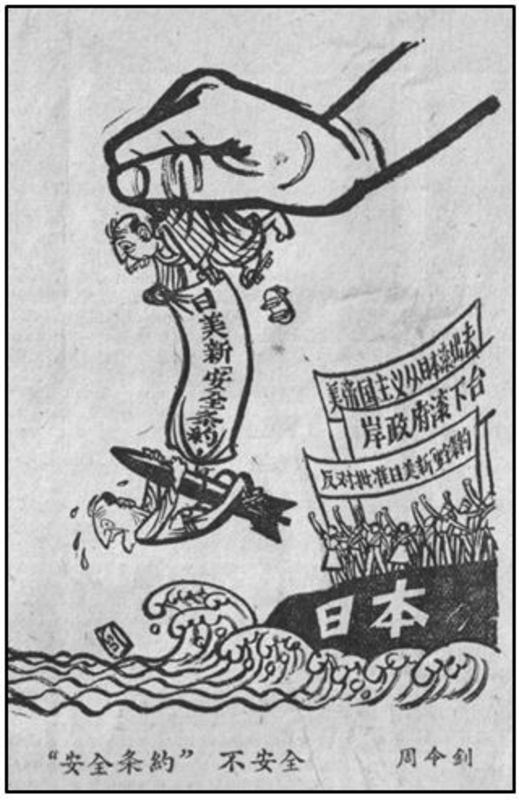
Figure 19.[sup]30[/sup][/td][td]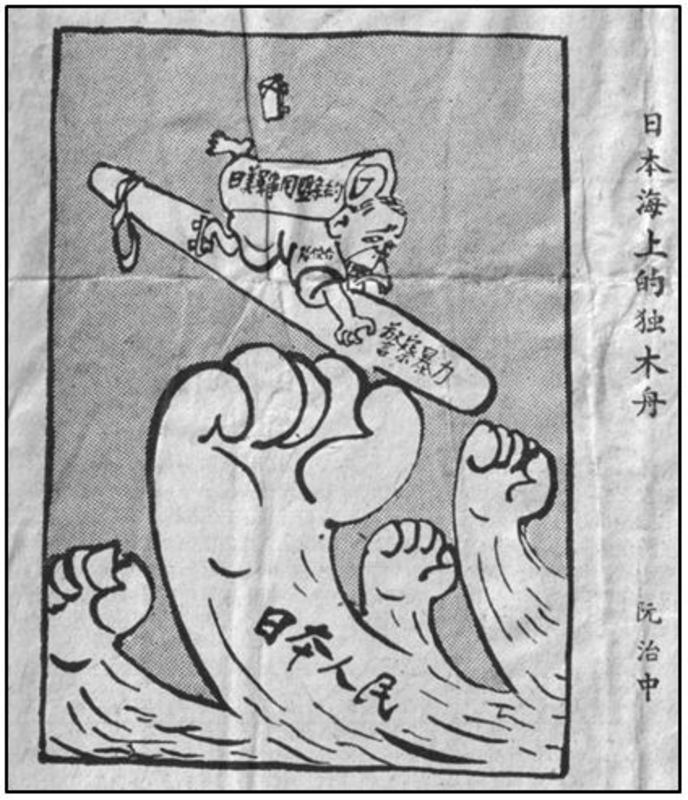
Figure 20.[sup]31[/sup][/td][/tr][/table]In Figure 23, as in the previous example, the hammer and sickle of the Soviet Union is the primary instigator behind the protests in Japan, as the hapless protester is spurred to action solely by the prick of the blade, while the caption sarcastically labels it a “spontaneous uprising.” Also worth noting, however, is that the wooden clogs (geta) worn by the protester in this case, here shown to be the Socialist Party, represent his backwardness and incompetence much as such footwear was used inPeople’s Dailydepictions of Prime Minister Kishi. For the American audience, then, Japanese demonstrators are an unruly and un-‘civilized’ mob, while for the Chinese audience Japan’s political leadership represents feudal remnants of the past.
[table=400px][tr][td]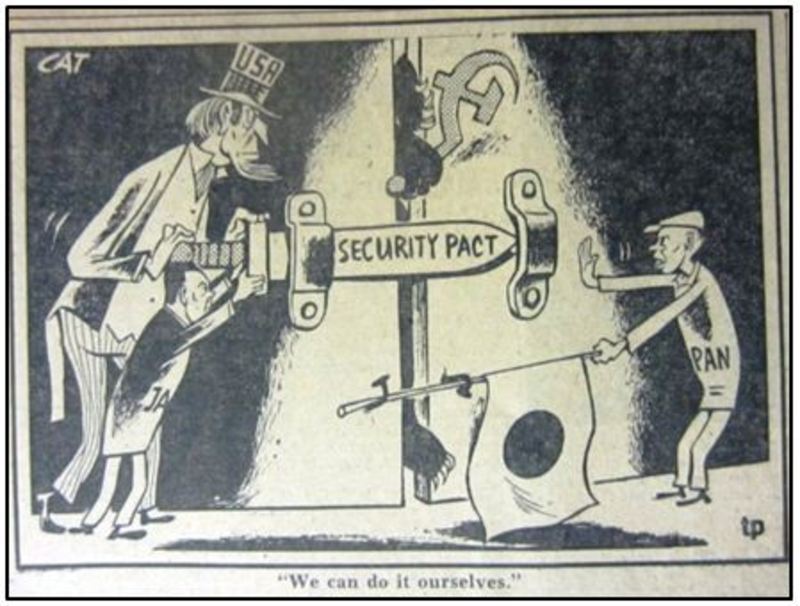
Figure 21.[sup]32[/sup][/td][td]
Figure 22.[/td][/tr][/table]The notion that popular Japanese anger over the security agreement and its autocratic ratification has a legitimate foundation is dismissed out of hand in all three of these representations. Interestingly, China is largely irrelevant in these depictions from the U.S. side; American cartoonists depicted Anpo protesters as stooges and dupes of Soviet agitation. While these comics cannot be taken as a direct statement of U.S. policy in East Asia, they reflect a fairly common sentiment in American political and public opinion at the time.
PRC cartoonists, by contrast, depict the real aggressor in East Asia in 1960 as the United States, as in the following two cartoons. Both embrace a critique of police brutality as it was widely employed against popular demonstrations during the summer of 1960 in Tokyo. Figure 24 shows Prime Minister Kishi’s face on the head of a police Billy club being snapped in half by the power of popular struggle against his government in the form of the righteous fist of the Japanese people delivering a blow to the Anpo Treaty. Notably, U.S. President Dwight Eisenhower is gently pushing Kishi under the fist with a caption reading: “Hold out as long as you can!” In Figure 25, Kishi and Eisenhower merge into one as they stand together under a military helmet labeled ‘ anpo’ (安保), while clubs reign blows upon them with the caption reading ‘neither safe 不安, nor secure不保’ , a clever play on the termanpoby making both of its component parts negative. In both, the United States, of course, is the main target of criticism, with Japanese society at large portrayed as the weak victim of American manipulation.
[table=200px][tr][td]
Figure 23[sup]34[/sup]
[/td][/tr][/table]To understand why this was such a dominant theme in the sources explored here, we must remember that images inThe People’s Dailywere intended primarily for domestic consumption. Why then did the CCP devote so much space in its flagship newspaper to the celebration of these seemingly revolutionary events in Japan during the summer of 1960? Indeed, front page headlines such as this one - “The Chinese and Japanese People Rise Up Together, Down with American Imperialism!” - were quite common for several weeks in May and June of that year.
[table=400px][tr][td]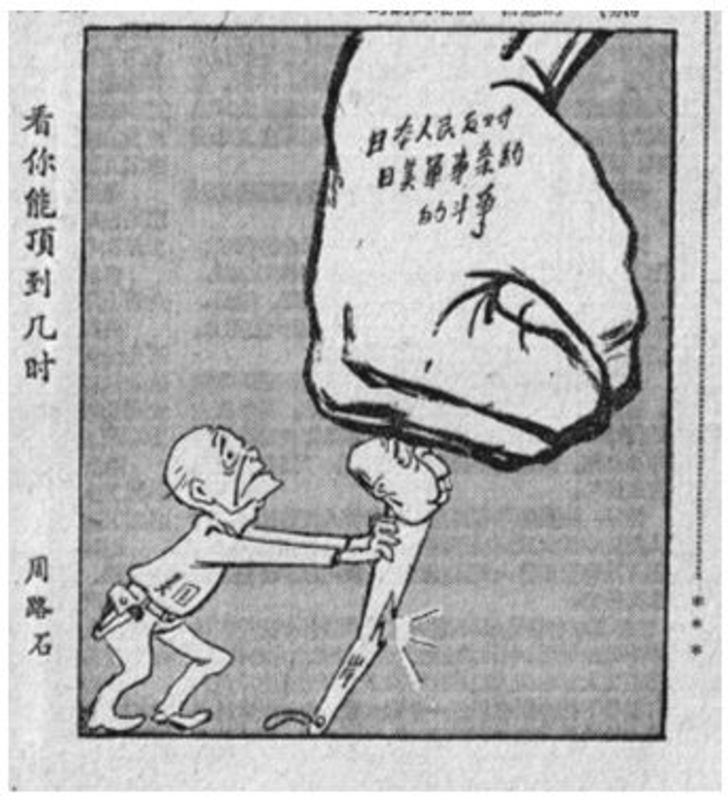
Figure 24[sup][sup][sup]35[/sup][/sup][/sup][/td][td]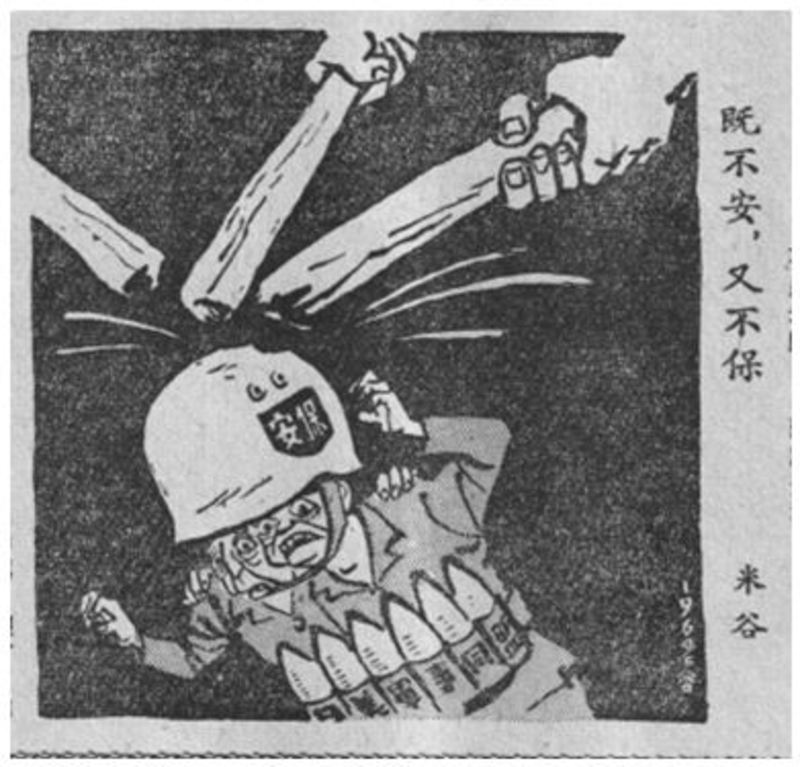
Figure 25[sup][sup][sup]36[/sup][/sup][/sup][/td][/tr][/table]The CCP anchored its legitimacy as the ruling party of China in part in its role as a leader of revolutionary movements in Asia and beyond. Perhaps then, by illustrating to the Chinese people that anti-American movements were breaking out around the world in 1960, a trend made possible by PRC leadership, the success of the party in both transforming China and inspiring popular resistance in neighboring societies such as South Korea and Japan could be reinforced. Such a message was important at a time when the disasters of the Great Leap Forward were evident to many (although not discussed openly), since one of the core goals of the GLF had been to rocket China forward to a position of leadership in global affairs. Moreover, 1960 saw the further deterioration and ultimate collapse of relations between the PRC and the Soviet Union. The image of a united Asia, under ostensible Chinese leadership, standing up to defeat American-backed authoritarian regimes could provide a weapon in the ideological polemics with the Soviet Union. The Soviet Union was no longer the vanguard of world revolution – that role now belonged to the PRC.
The transformation of Japan’s image here, however, is perhaps the most striking dimension of these cartoons. After the outbreak of the Korean War, the CCP sought to drive a wedge between Japan’s political elites under the thumb of American power and the Japanese ‘masses’ who could be seen as victims of America’s Cold War strategy of remilitarizing Japan.[sup]38[/sup]
By dramatically depicting the mass uprising of Japanese citizens in a bitter struggle to free themselves from American dominance during the summer of 1960, the CCP could continue this redirection of popular anger away from Japan and toward the U.S., and even cultivate a feeling of popular unity between the peoples of China and Japan, While this general strategy of “people’s diplomacy” as articulated by key party leaders such as Zhou Enlai has long been recognized by historians of the era, these cartoons fromThe People’s Dailyprovide a specific and highly illustrative example of just how this message was communicated to the Chinese people. Furthermore, while it was only a brief episode in the long term reconstruction of postwar China-Japan relations, these sources remind us nonetheless that the Anpo crisis of 1960 was an event of import in East Asian international affairs beyond the U.S.-Japan relationship.
[table=200px][tr][td]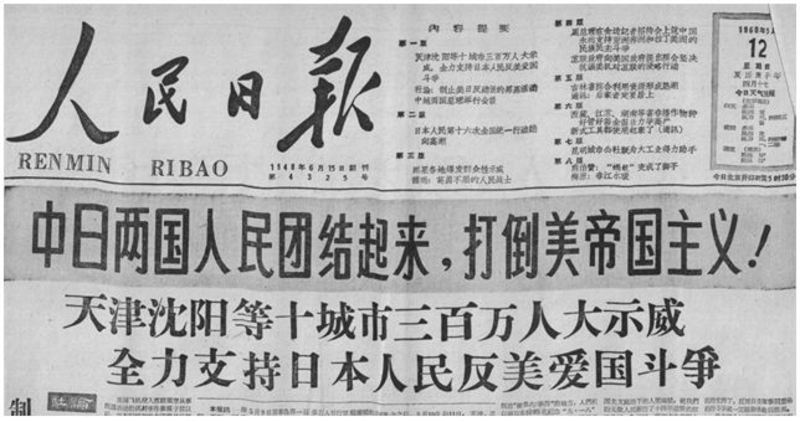
Figure 26[sup]37[/sup][/td][/tr][/table]Finally, it is also worth noting that many of the images and themes prevalent in Chinese editorial cartoons concerning the 1960 Anpo struggle can be found in Japanese editorial cartoons of the same time. In fact, at times they were identical, as in the case below of aPeople’s Dailycartoon that was reprinted from an original drawn by Nasu Ryōsuke 那須良輔 for theAsahi Shinbun朝日新聞. The cartoon shows a dark-suited American spy, complete with cowboy hat and holstered revolver (and labeled as a U-2 spy plane) being helped over a wall by Prime Minister Kishi in order to carry out his espionage missions in China and the Soviet Union. Such a critique of
Japanese state duplicity with aggressive American interference in Asian affairs was something shared quite comfortably by the Chinese Communist Party and many progressive intellectuals, writers, politicians, artists and cartoonists in Japan in the summer of 1960.
[table=400px][tr][td]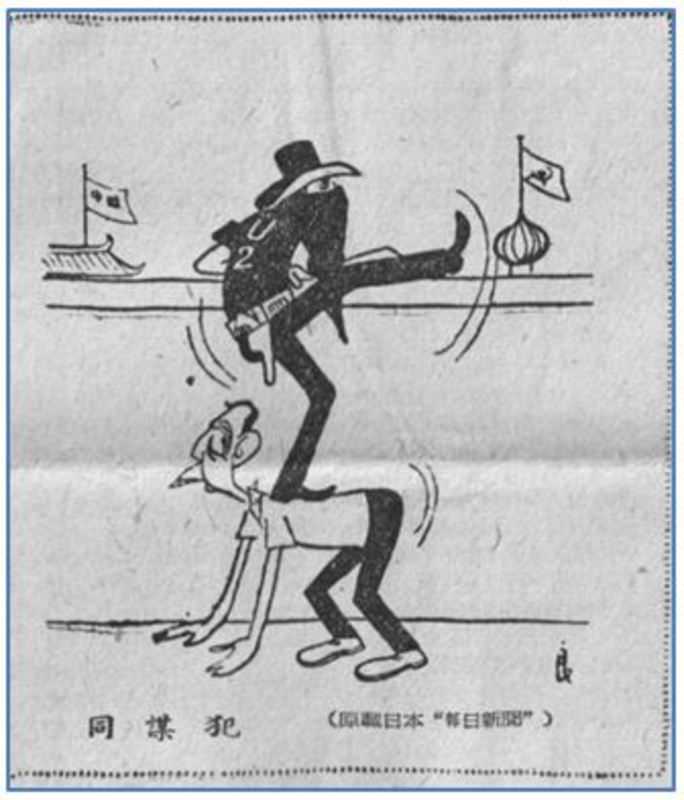
Figure 27.[sup]39[/sup][/td][td]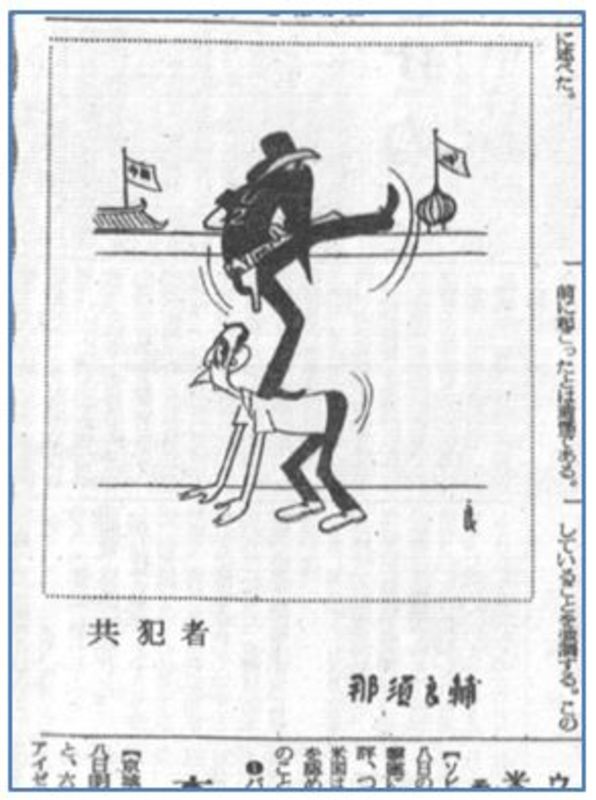
Figure 28.[sup]40[/sup][/td][/tr][/table]That these commonalities served to bind together certain elements of both societies during the early Cold War is worth remembering, especially at a time when political and territorial disputes pitting China against Japan over the Diaoyu/Senkaku Islands threaten to destabilize the entire region. Indeed, during the late 1950s and early 1960s, many people in China and Japan hoped to embark on a path toward reconciliation to protect their shared national interests against a powerful U.S. aggressor. As leaders in both places today attempt to chart a course between the heated diplomatic disputes that threaten their political ties and the economic imperatives that could unite them again, it might be useful to bear in mind that the notion of Sino-Japanese unity as the key to postwar regional stability and prosperity is not without precedent.
Erik Esselstromis Associate Professor in the Department of History and Director of the Asian Studies Program at the University of Vermont. He is the author ofCrossing Empire’s Edge: Foreign Ministry Police and Japanese Expansionism in Northeast Asia(University of Hawai’i Press, 2009).
Recommended citation: Erik Esselstrom, "The 1960 ‘Anpo’ Struggle in The People’s Daily /人民日報: Shaping Popular Chinese Perceptions of Japan during the Cold War,"The Asia-Pacific Journal, Vol 10 Issue 51, No. 1, December 17, 2012.
Articles on related topics
• Linda Hoaglund,ANPO: Art X War – In Havoc’s Wake
• Sabine Frühstück,AMPO in Crisis? US Military's Manga Offers Upbeat Take on US-Japan Relations
•Gavan McCormack, Ampo’s Troubled 50[sup]th[/sup]: Hatoyama’s Abortive Rebellion, Okinawa’s Mounting Resistance and the US-Japan Relationship (3 part series)
Notes
[sup]1[/sup]Renmin ribao人民日報, June 15, 1960. Interestingly, the Chinese phrase used to identify the treaty here is 日美軍事同盟 (Japan-U.S. Military Alliance), notthe日米安保条約 (Japan-U.S. Security Agreement) as it is referred to in Tokyo and Washington, D.C.
[sup]2[/sup]The literature is too vast to summarize here, but one excellent example that includes analysis of historical memory in numerous Asian societies is Sheila Miyoshi Jager and Rana Mitter, eds.,Ruptured Histories: War, Memory and the Post-Cold War in Asia(Harvard University Press, 2007).
[sup]3[/sup]See Rana Mitter, “Old Ghosts, New Memories: China’s Changing War History in the Era of Post-Mao Politics”Journal of Contemporary History38:1 (January 2003): 117-131; James Reilly, “Remember History, Not Hatred: Collective Remembrance of China’s War of Resistance to Japan”Modern Asian Studies45:2 (2011): 463-490.
[sup]4[/sup]A useful recent study of the general history of Chinese political cartoons is Tao Ye陶治,Chūgoku no fūshi manga中国の風刺漫画 (Hakuteisha 白帝社, 2007).
[sup]5[/sup]The classic work on the Anpo protests is George R. Packard,Protest in Tokyo: The Security Treaty Crisis of 1960(Princeton University Press, 1966). A recent study is Linda Hoaglund’s film,ANPO: Art X War-link.
[sup]6[/sup]A valuable discussion of how popular Chinese perceptions of the United States changed during the immediate postwar years is Hong Zhang,America Perceived: The Making of Chinese Images of the United States, 1945–1953(Westport: Greenwood, 2002).
[sup]7[/sup]Both of these points are consistent with the basic principles of China’s ‘people’s diplomacy’ strategy concerning Japan in the 1950s. See He Yinan, “Remembering and Forgetting the War: Elite Mythmaking, Mass Reaction, and Sino-Japanese Relations, 1950-2006”History & Memory19:2 (Fall/Winter 2007): 43-74.
[sup]8[/sup]See Parks M. Coble, “China’s ‘New Remembering’ of the Anti-Japanese War of Resistance”The China Quarterly190 (June 2007): 394-410.
[sup]9[/sup]James Reilly,Strong Society, Smart State: The Rise of Public Opinion in China’s Japan Policy(New York: Columbia University Press, 2012), 55.
[sup]10[/sup]Renmin ribao,May 23, 1960.
[sup]11[/sup]Renmin ribao,June 24, 1960.
[sup]12[/sup]Renmin ribao,May 5, 1960.
[sup]13[/sup]Renmin ribao,May 6, 1960.
[sup]14[/sup]John M. Wander Lippe, “Forgotten Brigade of the Forgotten War: Turkey’s Participation in the Korean War”Middle Eastern Studies36:1 (January 2000): 92-102.
[sup]15[/sup]For a contemporary discussion of the incident, see Qunicy Wright, “Legal Aspects of the U-2 Incident”The American Journal of International Law54:4 (October 1960): 836-854.
[sup]16[/sup]Renmin ribao,May 22, 1960.
[sup]17[/sup]Renmin ribao,May 30, 1960.
[sup]18[/sup]Mark Driscoll provides an especially damning portrait of Kishi’s role in overseeing Japanese exploitation of Chinese labor in Manchukuo in Chapter Eight of hisAbsolute Erotic, Absolute Grotesque: The Living, Dead and Undead in Japan’s Imperialism, 1895-1945(Durham, NC: Duke University Press, 2010).
[sup]19[/sup]Renmin ribao, May 17, 1960.
[sup]20[/sup]Close-up from Figure 17.Renmin ribao,May 22, 1960.
[sup]21[/sup]Close-up from Figure 5.Renmin ribao,May 6, 1960.
[sup]22[/sup]Close-up from Figure 16.Renmin ribao,May 30, 1960.
[sup]23[/sup]Close-up from Figure 19.Renmin ribao,May 25, 1960.
[sup]24[/sup]Renmin ribao,June 23, 1960.
[sup]25[/sup]Renmin ribao,May 17, 1960.
[sup]26[/sup]For additional discussion of Mt. Fuji imagery in wartime Japan and beyond, see H. Byron Earhart, “Mt. Fuji: Shield of War, Badge of Peace” inThe Asia-Pacific Journal Vol 9, Issue 20 No 1, May 16, 2011(link), as well as Earhart’s book,Mt. Fuji: Icon of Japan(University of South Carolina Press, 2011).
[sup]27[/sup]Renmin ribao,May 25, 1960.
[sup]28[/sup]Renmin ribao,May 22, 1960.
[sup]29[/sup]Renmin ribao,May 29, 1960.
[sup]30[/sup]Renmin ribao,May 15, 1960.
[sup]31[/sup]Renmin ribao,June 3, 1960.
[sup]32[/sup]The Japan Times, June 15, 1960.
[sup]33[/sup]The Japan Times, July 8, 1960.
[sup]34[/sup]The New York Times, June 12, 1960 (reprinted from the original cartoon in theThe Greensboro Daily News)
[sup]35[/sup]Renmin ribao,June 10, 1960.
[sup]36[/sup]Renmin ribao,May14, 1960.
[sup]37[/sup]Front page ofRenmin ribao, May 12, 1960.
[sup]38[/sup]He, “Remembering and Forgetting the War,” 47.
[sup]39[/sup]Renmin ribao,May 13, 1960.
[sup]40[/sup]Renmin ribao,May 9, 1960.
原文地址:http://japanfocus.org/-Erik-Esselstrom/3867 |
|